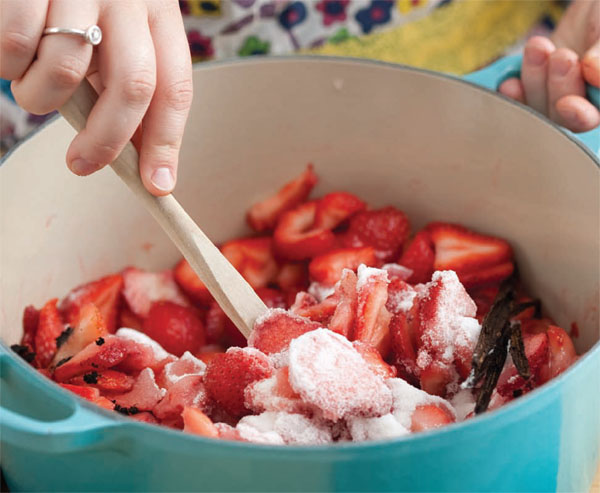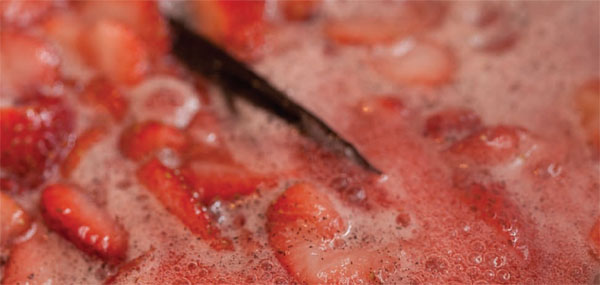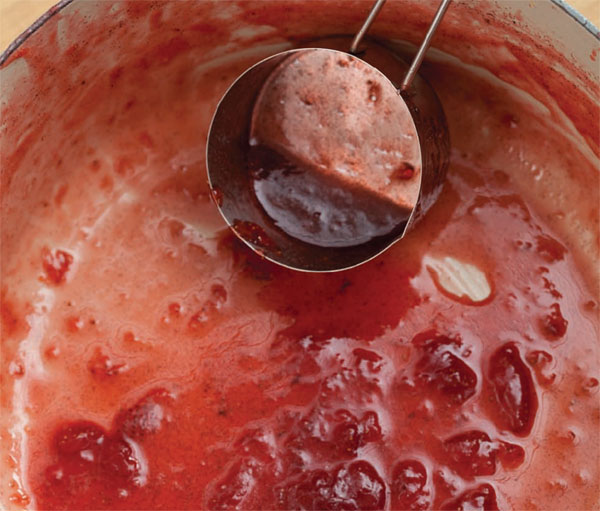Food in Jars (4 page)
Authors: Marisa McClellan

A
T THE END OF A COLD WINTER, THERE'S LITTLE
that makes me happier that the arrival of rhubarb. It means that spring is close (even if the mercury hasn't gotten the message yet). Some years I wait until the local strawberries arrive to make this jam, others I cheat and use frozen. Obviously, you get the best flavor from the local ones, but after a Northeast winter, it's hard not to want to jump the gun a little. For those of you fond of strawberry rhubarb pie, this jam is a nice substitute.
6 cups chopped rhubarb (about 2½ pounds/1 kg rhubarb stalks)
4 cups chopped strawberries (about 2 dry pints/715 g strawberries)
Zest and juice of 2 oranges
5 cups/1 kg granulated sugar
1 teaspoon ground cinnamon
2 (3-ounce/85 ml) packets liquid pectin
Prepare a boiling water bath and 5 regular-mouth 1-pint/500 ml jars according to the process on page 10. Place the lids in a small saucepan, cover them with water, and simmer over very low heat.
In a large, nonreactive pot, combine the rhubarb, strawberries, orange zest and juice, sugar, and cinnamon and stir to incorporate. Bring to a boil and reduce heat to a simmer.
Let the fruit cook over medium-high heat (you want bubbles but not a vigorous boil) for approximately 15 to 20 minutes, until the rhubarb breaks down (if there are a few pieces here and there, it's okay, just as long as they are soft enough to break down with the back of a wooden spoon) and the jam has developed a glossy shine.
Add the pectin and increase the heat to high, letting the jam boil vigorously for 5 minutes. Remove the pot from the heat and ladle the jam into the prepared jars. Wipe the rims, apply the lids and rings, and process in a boiling water bath for 10 minutes (see
page 11
).



E
VERYONE THINKS THEY KNOW WHAT STRAWBERRY
jam tastes like. That is, until they make it from scratch, with thoroughly red berries that were bred for flavor instead of an ability to travel. Truly, the homemade version is toe-curlingly good. Getting a good set out of strawberry jam is hard because there's not much in the way of natural pectin in these berries. However, if your finished product turns out to be closer to syrup than jam, don't apologize for it. Simply call it strawberry preserves and tell everyone it's exactly as you intended it to be. No one will be the wiser. You should also note that this jam calls a maceration period before cooking. This helps draw the juices out of the fruit and makes for a more luscious jam.
8 cups hulled and chopped ripe strawberries (about 2 dry quarts/1.4 kg strawberries)
5 cups/1 kg granulated sugar, divided
2 vanilla beans, split and scraped
Zest and juice of 2 lemons
2 (3-ounce/85 ml) packets liquid pectin
In a nonreactive bowl, combine the chopped strawberries with 1 cup/200g of the sugar and the vanilla bean seeds and pods. Let the mixture sit at room temperature until the sugar begins to pull the liquid out of the berries, about 15 to 30 minutes, then cover and refrigerate overnight. If you don't want to wait overnight (or don't have the refrigerator space), even just 1 hour of maceration is better than none at all.
When you're ready to make the jam, prepare a boiling water bath and 4 regular-mouth 1-pint/500 ml jars according to the process on page 10. Place the lids in a small saucepan, cover them with water, and simmer over very low heat.
Remove the macerated strawberries from the refrigerator and pour everything into a large, nonreactive pot. Add the remaining 4 cups/800 g of sugar and lemon zest and juice and stir to combine. Bring to a boil over high heat (this jam will foam madly) and cook on high heat for 15 to 20 minutes, stirring regularly, until it takes on a thick, syrupy consistency.
Remove the vanilla bean pods from the mixture. If you have an immersion blender, use it at this point to purée some of the fruit. Alternatively, transfer about a third of the jam to a blender and purée, then return puréed fruit to pot.
Add the pectin to the fruit mixture and bring to a rolling boil. Insert your candy thermometer into the jam and attach it to the side of the pot. Let the jam boil vigorously until it reaches 220°F/105°C.
Once the jam reaches 220°F/105°C and remains at that temperature for 2 minutes, remove the pot from the heat and ladle the jam into the prepared jars, leaving ½ inch headspace. Wipe the rims, apply the lids and rings, and process in a boiling water bath for 10 minutes (see
page 11
).


A
PRICOT WAS NOT PART OF MY CHILDHOOD REPERTOIRE
of jams. When it came to homemade jams, we were more of a plum and blueberry crowd. So I never gave it much thought until the day someone introduced me to the company “We Love Jam” and their Blenheim apricot jam, and it blew my preserve-lovin' mind. While I can't get those precious Blenheims where I live, I've found that just about any locally grown, tree-ripened apricot makes stellar jam and I can't really see going a year without its sweet-tart goodness for spreading on buttered toast.
6 cups peeled, pitted, and diced apricots (about 3 pounds/1.4 kg whole apricots)
3½ cups/700 g granulated sugar
Zest and juice of 1 lemon
Prepare a boiling water bath and 4 regular-mouth 1-pint/500 ml jars according to the process on page 10. Place the lids in a small saucepan, cover them with water, and simmer over very low heat.
Combine the apricots and sugar in a large pot and bring to a boil over medium-high heat. Boil for 10 to 15 minutes, until the fruit is tender and the liquid looks syrupy.
Add the lemon juice and zest and return to a boil. Insert your candy thermometer into the jam and attach it to the side of the pot. Let the jam boil vigorously until it reaches 220°F/105°C.
When the jam has reached 220°F/105°C and the temperature has remained steady for 2 minutes, remove the pot from the heat and ladle the jam into the prepared jars. Wipe the rims, apply the lids and rings, and process in a boiling water bath for 10 minutes (see
page 11
).

I
BELIEVE THAT SOUR CHERRY JAM WAS THE ORIGINAL
inspiration for those little rolls of Sweet Tarts that we all ate as kids. Also known as tart or pie cherries, sour cherries are bright, tangy (but not sour exactly, just perfectly piquant) and, when combined with a bit of sugar and cooked into jam (or baked in a pie), they walk the line between pleasantly sweet and achingly puckery. They are hard to find commercially, but tend to make appearances at farmers' markets in June or July. Keep your eyes peeled and when you find them, make this jam.
6 cups pitted and mashed sour cherries (about 3 pounds/1.4 kg whole cherries)
3 cups/600 g granulated sugar
1 (3-ounce/85 ml) packet liquid pectin
Prepare a boiling water bath and 4 regular-mouth 1-pint/500 ml jars according to the process on page 10. Place the lids in a small saucepan, cover them with water, and simmer over very low heat.
Combine the cherries and sugar in a large pot. Bring to a boil over high heat and let it bubble for a good 20 minutes, occasionally skimming the foam from the surface of the fruit as it develops. Add the pectin and boil for another 5 minutes. You want to cook it until the bubbles are thick and look like molten lava.
